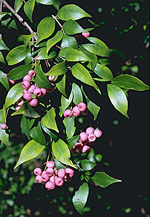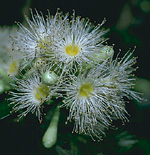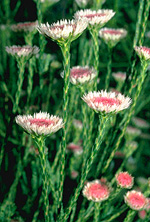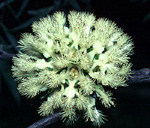 |
This is one of the most characteristic Australian families, providing the dominant species in most Australian vegetation communities except treeless areas, rainforests and those communities of arid and semi-arid regions dominated instead by Acacia (Mimosaceae). There are two broad centres of diversity, one in the wetter rainforests of the east and north-east and another in sclerophyllous heath and shrublands on poor soils of the south-west and south-east. Many genera are endemic to one or other of these broad regions.
Characteristic features of the family Myrtaceae in Australia include: - trees or shrubs with opposite or alternate, entire leaves, usually with translucent oil glands
- flowers usually relatively small but sometimes aggregated into dense, showy heads or spikes
- petals 4 or 5, free, white, pink to red or yellow, sometimes reduced or absent, often less prominent than the stamens which may be numerous and brightly coloured
- ovary inferior (enclosed in a fleshy hypanthium-tube), developing into a capsule which opens by radial splits, or a fleshy drupe or berry
Description
Evergreen, deciduous or semi-deciduous trees or shrubs. Stems unarmed or rarely with thorns or spines arising from the leaf axils; internodes terete or distinctly angular. Vegetative reproduction absent, or by rhizomes, stolons or root suckers. Internal secretions not obvious or of coloured sap, essential oils or resin. Plants glabrous, or with simple, glandular or non-glandular, unicellular, uniseriate or multiseriate hairs. Leaves alternate and spiral, or opposite, or in whorls of 3–5, petiolate, subsessile or sessile, or rarely peltate; pulvinae present or absent. Stipules present or absent. Lamina simple, symmetric or conspicuously asymmetric, filiform, acicular, subulate, linear, lanceolate, ovate, elliptic, oblanceolate, ovate, oblong, spathulate or orbicular; base cuneate, attenuate, rounded, cordate, hastate or sagittate or oblique; margins entire, rarely crenate, dentate or sinuate, ±flat, revolute or recurved; one-veined, or the venation pinnate, or parallel, or rarely palmate, with the midrib conspicuous or inconspicuous, and the tertiary venation reticulate or not; surfaces dark- or pellucid-punctate, or not punctate; herbaceous, leathery or hard and spinose; distinctive odour absent or aromatic. Domatia present. All the flowers bisexual, or with male and bisexual flowers occurring together. Inflorescences terminal, axillary, cauliflorous or ramiflorous, consisting of capitula or glomerules, spikes, racemes, panicles, umbels, dichasial cymes or solitary flowers. Bracts and bracteoles present or absent. Pollination by insects, birds, bats or small mammals. Flowers odourless or fragrant, sessile or stalked. Floral disc present or absent; nectaries absent or present on the disc. Free hypanthium present or absent. Perianth regular, of 2 dissimilar whorls, or of 1 whorl only, or whorls ±similar, or apparently absent, imbricate in bud. Calyptra present or absent. Calyx segments free or fused, with 0 or 4–5 (–6) sepals or lobes; calyx rarely cup-shaped or bell-shaped, herbaceous, succulent or papery, rarely membranous, sometimes modified into a pappus, rarely comprised of bristles or scales, sometimes fused to form a calyptra with the petals. Corolla segments free, or fused as a calyptra, or rarely a distinct tube or cup, with (0–) 1 or 4–5 (–6) petals or lobes, alternating with the sepals or calyx lobes, white, cream, yellow, orange, red, pink, magenta, purple, violet, green, without contrasting markings, membranous; claws present or absent; lobes ±entire, or trifid, trilobed or more divided, or ciliate or fimbriate. Fertile stamens 3–numerous, alternating or not clearly correlated with the sepals or calyx lobes, free of the corolla, free of ovary and style, distinct from each other, grouped or fused into bundles or fused by their filaments into an open or closed tube, all ±equal or distinctly alternating long and short. Staminodes present or absent. Anthers dorsifixed or basifixed, versatile or not versatile, opening inwards or terminally by pores, by short slits, by longitudinal slits or by valves, 2-celled; appendages absent or apical. Ovary part-inferior or inferior. Carpels 1–10, fused; ovary with 1–11 locules. Style terminal, single, unbranched, truncate, capitate or peltate. Ovules 1–numerous per locule, stalked or sessile; placentation basal, apical, parietal or axile. Fruit derived from a single flower or from several flowers (composite), dry or fleshy, dehiscent or indehiscent; a capsule with irregular, circumscissile or loculicidal dehiscence, a nut or berry, or rarely aggregated into a globular woody head (capsiconum); the perianth on the maturing fruit deciduous, or dry and persistent. Disseminule macro-surface featureless, winged or awned; micro-surface ±smooth, white, yellow, orange, red, pink, magenta, purple, violet, green, brown, grey or black, glossy or dull. Seeds 1–numerous per fruit. Aril absent. Cotyledons 2. Embryo straight, curved, sharply bent, coiled or round or shapeless.
(Note: this description has been generated from the coded data compiled for the key. Any errors in the key data will be reflected in the descriptions.)
A treatment of part of the family Myrtaceae has been published in:
Flora of Australia 19: 1-456 (Eucalyptus and Angophora)
only; remaining genera will be dealt with in Volumes 20 & 21.
Australian genera of Myrtaceae (as recognised for the Flora of Australia)
* = all species introduced
Acmena
Acmenosperma
Actinodium
Agonis
Allosyncarpia
Angasomyrtus
Angophora
Archirhodomyrtus
Astartea
Austromyrtus
Backhousia
Baeckea
Balaustion
Barongia
Beaufortia
Callistemon
Calothamnus
Calythropsis
Calytrix
Chamelaucium
Choricarpia
Cleistocalyx
Conothamnus
Corymbia
Corynanthera
Darwinia
Decaspermum
Eremaea
Eucalyptopsis
Eucalyptus
Homalocalyx
Homalospermum
Homoranthus
Hypocalymma
Kunzea
Lamarchea
Leptospermum
Lindsayomyrtus
Lophostemon
Lysicarpus
Malleostemon
Melaleuca
Metrosideros
Micromyrtus
Mitrantia
Myrtella
*Myrtus
Ochrosperma
Osbornia
Pericalymma
Phymatocarpus
Pileanthus
Pilidiostigma
*Psidium
Regelia
Rhodamnia
Rhodomyrtus
Rinzia
Ristantia
Scholtzia
Sinoga
Sphaerantia
Syncarpia
Syzygium
Thryptomene
Tristania
Tristaniopsis
Uromyrtus
Verticordia
Waterhousea
Wehlia
Welchiodendron
Xanthostemon

|
  |

Acmena smithii (fruits)
Photo: M.Fagg © M.Fagg

Acmenosperma claviflorum (flowers)
Photo: H.Nicholson © H. & N. Nicholson

Actinodium cunninghamii (flowers)
Photo: D.Greig © ANBG

Asteromyrtus magnifica (flowers)
Photo: G.Sankowski © Zodiac Publications

|
 |
|